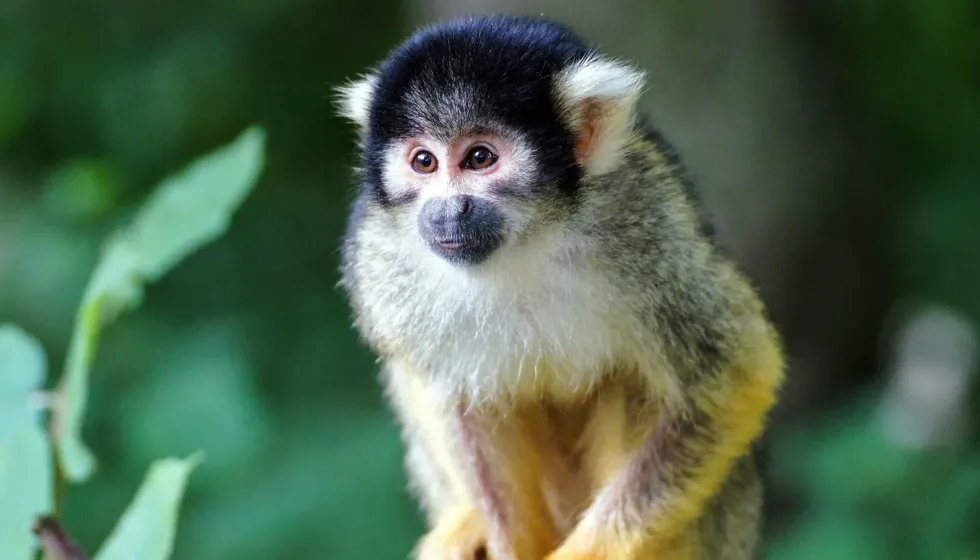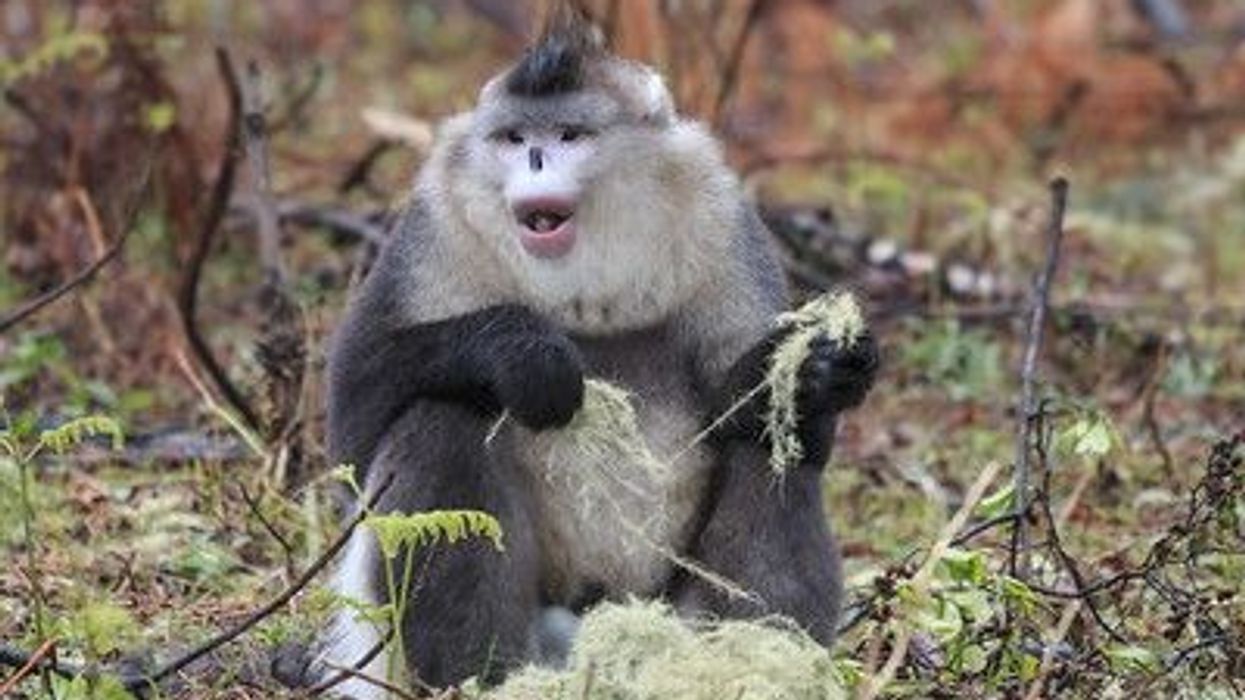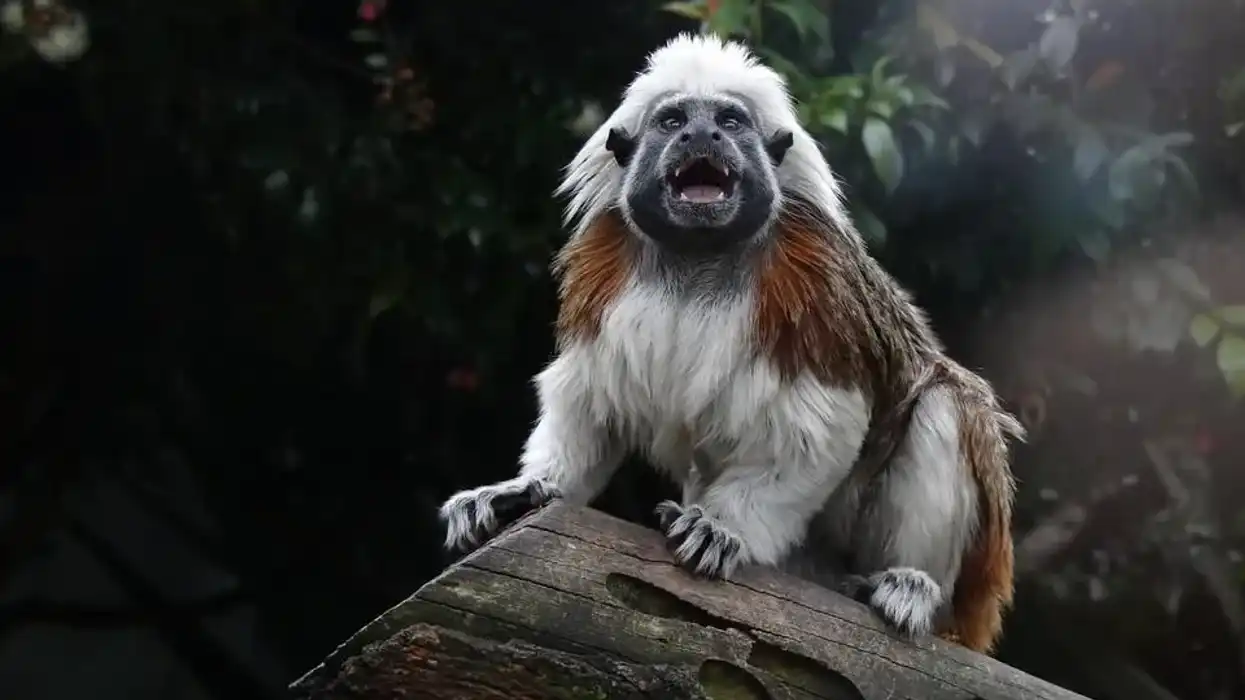Know what is the first thing you will notice in this squirrel monkey? Black face, long tail, and vibrant red tail!
Saimiri vanzolinii is probably one of the most adorable primates you will come across. They are also known by other names, such as black-headed squirrel monkey, black squirrel monkey, or even blackish squirrel monkey. The blackish squirrel monkey population is mainly centered around Central and South America.
These squirrel monkeys reach their sexual maturity at the age of 2.5 years. The gestation period of these black-headed squirrel monkeys lasts for a maximum of 170 days. They are known to enjoy eating fruits and insects. Unfortunately, the conservation status of this species has been mentioned as 'Endangered' in the IUCN Red List.
For more relatable content, check out these titi monkey facts and bush baby facts for kids.
Black Squirrel Monkey Interesting Facts
What type of animal is a black squirrel monkey?
The black-headed squirrel monkey is a type of squirrel monkey species.
What class of animal does a black squirrel monkey belong to?
This black-headed squirrel monkey of South America belongs to the class of mammals.
How many black squirrel monkeys are there in the world?
The black squirrel monkey population size is not exactly known.
Where does a black squirrel monkey live?
These black-headed squirrel monkeys are found primarily in the Central and South America region. They are entirely endemic to the lands of the central Amazon on the Brazilian lands.
Of all the South American primates, this species of squirrel monkey has the most limited geographic range.
Blackish squirrel monkeys live in the várzea forest of the Amazonian floodplain, located at the convergence of the Japura, Solimões, and Amazon rivers. The entire range of this species of squirrel monkeys under the genus Saimiri is within the Brazilian Mamirauá Sustainable Development Reserve.
What is a black squirrel monkey's habitat?
The natural habitat of the black-headed squirrel monkeys includes tropical rainforests, laying at lower elevations between 75.5-262.5 ft (23-80 m). However, these squirrel monkeys tend to adjust in varied forest habitats as well, such as edge forests, logged tropical lands, and evergreen forests. They prefer staying up on the trees in any forest.
Who do black squirrel monkeys live with?
These New World monkeys live in large groups, which may have up to 500 members.
How long does a black squirrel monkey live?
The black squirrel monkey average lifespan is said to be about 15 years of age. However, they are known to live for 5-10 years longer, when kept safe in captivity.
How do they reproduce?
The breeding season of these New World monkeys falls between September to November. There is a trend in this squirrel monkey species where all male monkeys who have well-fattened stomachs are viewed as more desirable ones by the female squirrel monkeys.
Female squirrel monkeys have a gestation period of about 145-170 days months and give birth between February to April. The time of the birth is well coordinated with the rainy season, when ample food will be available and dietary needs would not pose any issues. Usually, there is only a single infant born.
Though there is not much information on the mating activities, there is good knowledge on that of the Saimiri sciureus. These monkeys are polyandrous. Females reach their sexual maturity at the age of 2.5 years, however, males might mature between the age of 2.5-4 years.
For a few weeks after their birth, the young monkey clings on to its mother everywhere she goes. The babies grow quickly, adapting to the environment around them. They become independent by 12 months of their birth.
The male squirrel monkey usually does not contribute to raising his baby, whereas the female would nurse the baby until they reach the age of six months.
What is their conservation status?
For the black squirrel monkey, IUCN Red List has stated the conservation status as 'Endangered'.
Black Squirrel Monkey Fun Facts
What do black squirrel monkeys look like?
These squirrel monkeys (Saimiri vanzolinii) are small, adorable primates. These New World monkeys have black-gray fur on almost every part of the body, except the stomach and the legs. The stomachs have a slight yellowish hue, while the legs may be yellow or reddish.
The fur is dense and short everywhere. Only parts of the face have a slightly varied fur texture. The lips and nostrils do not have hair, and instead have black skin tone in those areas. Most specimens are white around the neck and the eyes.
As these monkeys rest, their tails curl over and rest on the shoulder. The tail is much thicker than the remaining body parts. They are known to have extremely sharp nails. They have big, dark eyes.
The name of this animal comes from the black fur extending from the head all the way to the tip of the tail. Compared to other Saimiri species, the fur above the eyes is much lower on the foreheads, and the hair above the eyes forms an arch.

How cute are they?
The black squirrel monkey is absolutely adorable! Cute would be an understatement!
How do they communicate?
These New World monkeys are generally very quiet. You can hear various calls of them only when they are trying to speak to others of their species, or when they sense danger around them. In situations of alarm, they produce a loud shrill sound.
They also spread urine properly on their hands and feet, which conveys an individual’s reproductive status. They are also known to speak through body stances and facial expressions. Other known calls include cackles, twitters, chuck-chucks, and many more.
How big is a black squirrel monkey?
The black squirrel monkey length falls in the range of 10.63-12.6 in (27-32 cm). Including the tails, they would be about 15.75 in (40 cm) longer.
This makes them about four times the size of the Indian Palm Squirrel.
How fast can a black squirrel monkey move?
Black-headed squirrel monkeys (Genus: Saimiri) can move up to speeds of 22 mph (35.4 kph).
How much does a black squirrel monkey weigh?
A male black-headed squirrel monkey weighs about 1.4-2.8 lb (635.03-1270.06 g). The female black-headed squirrel monkey weighs in the range of 1.4-2 lb (635.03-907.185 g).
What are the male and female names of the species?
There are no specific names for the male and female squirrel monkeys of genus Saimiri.
What would you call a baby black squirrel monkey?
There is no name for a baby of this squirrel monkey.
What do they eat?
Black-headed squirrel monkeys have an omnivorous diet. This species is known to feed on plant matter such as leaves, fruits, flowers, seeds, and nectar. They also munch on small insects, eggs, and small vertebrates such as small birds and bats.
They are actually very smart, waiting for insects to settle down on trees or plants, and then surprising them with an attack. Common insect food includes crickets, caterpillars, and grasshoppers. Even arthropods, lizards, nuts, and flower buds are a part of their diet.
Are they poisonous?
No, the black-headed squirrel monkey is not at all poisonous.
Would they make a good pet?
We do not think this species of squirrel monkeys would make good pets! Apparently, it is very difficult to tame them. However, they have been involved in the pet trade as well, being sold for about $4000 to $8000.
Did you know...
There are a total of five different species of squirrel monkeys under the genus Saimiri who are currently existing. They are broadly classified into two groups. There is another group of fosilled species having two animals under it.
Saimiri sciureus, also popularly referred to as the common squirrel monkey, is the closest relative of the black-headed squirrel monkey (Saimiri vanzolinii).
The main predators of this Southern and Central American Squirrel monkey are felids, raptors such as hawks, falcons, and eagles, and large snakes.
Black-headed squirrel monkeys have a lot of resemblance to black-capped squirrel monkeys.
The Central American squirrel monkey (Saimiri oerstedii) is popular as the red-backed squirrel monkey.
The blackish squirrel monkey is entirely active during the day hours.
Are black squirrel monkeys endangered?
Yes, the conservation status of this squirrel monkey under genus Saimiri has been declared as 'Endangered' in the IUCN Red List. Main threats to the population of this squirrel monkey include loss of habitat and illegal poaching.
These squirrel monkeys are also known to be captured for various medicinal purposes or for being sold as pets. Their habitat is very localized, thus causing greater problems to their population.
There are also instances where the black-headed squirrel monkey has undergone hybridization with different species of genus Saimiri. Thus, the true black-headed squirrel monkeys are declinings.
Why are they called black squirrel monkey?
No, no. These monkeys are in no way related to squirrels. However, they get their name from their usual behavior.
Squirrel monkeys are arboreal creatures. They live entirely among the trees, and most of their time is spent just hopping between the branches. They are quick, energetic, small, just like squirrels. They are also named so for their tree-hugging abilities.
Here at Kidadl, we have carefully created lots of interesting family-friendly animal facts for everyone to discover! For more relatable content, check out these baboon facts and vervet monkey facts pages.
You can even occupy yourself at home by coloring on one of our free printable black squirrel monkey coloring pages.









